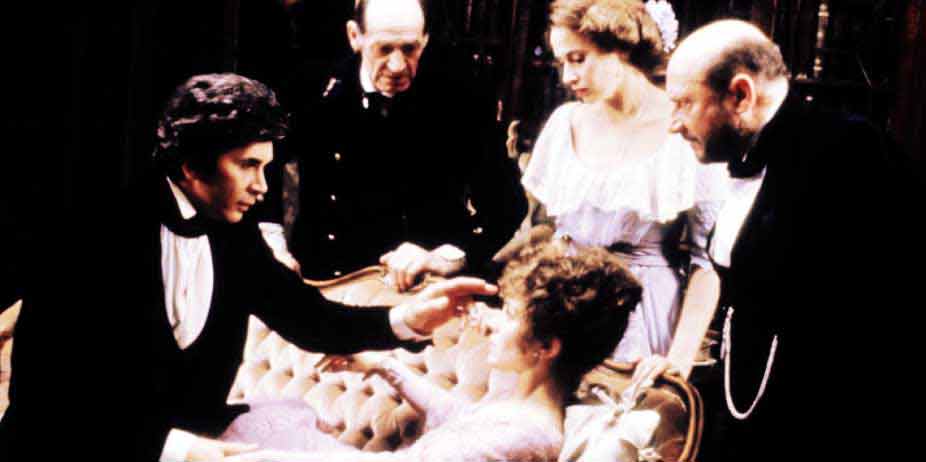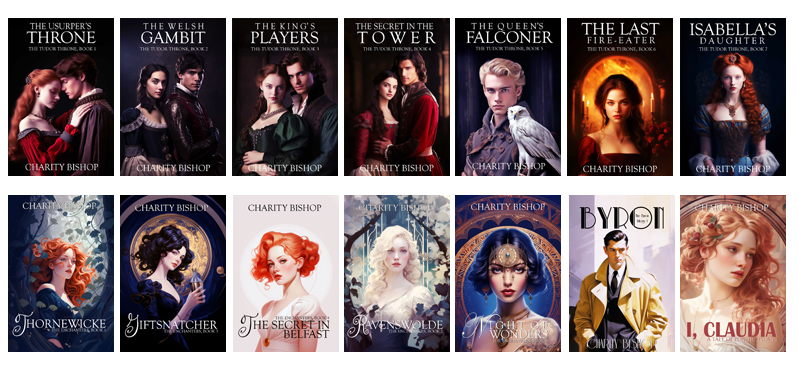Dracula (1979)
This version of Dracula is a "romanticized" version of the Broadway production starring Frank Langella. He created such a stir on the stage that producers immediately realized he had big box office potential. The film did only fair in theatres, but has become a classic, a tragic romance tinted with a hint of horror.
In the midst of a violent storm, the crew of a small shipping vessel is attempting to force a large crate overboard. They only succeed in unleashing the rage of the creature within, and it turns on them, leaving none alive in a gruesome attack. The Demeter runs aground on the rocky shoreline of Whitby. The crash is witnessed by frail Mina Van Helsing (Jan Francis), a guest of the caretakers of the local mental asylum. Slipping out into the darkness to investigate, Mina comes across the only apparent survivor, Count Dracula (Frank Langella). Alive and unharmed, he seems none the worse for wear and accepts the invitation of Dr. Seward (Donald Pleasence) to come to dinner the following evening. The mysterious and morbid circumstances surrounding the shipwreck have the locals spooked, and London solicitor Jonathan Harker (Trevor Eve) is not put at ease to find that his client has drawn the interest of Dr. Seward's daughter Lucy (Kate Nelligan).
When Mina's illness takes an unexpected turn for the worse, word is sent to her father (Laurence Olivier) to come at once. His arrival sets in motion an immortal battle over the body and soul of Lucy, who Dracula has chosen to be his bride. There is not so much deception in this adaptation as cunning, for it presents the story in a unique approach that caters to the romantic rather than the horrific. This is the only production to make Dracula a mesmerizing and attractive antihero. The producers admit it was made for women, built around their fantasies of what Dracula imbibes: gentlemanly elegance and gothic sexuality. Langella appeals to what women want most in men, from his sense of stillness to the liquid, soft tones of his voice. It's a wonderful performance. He is a completely empathetic Dracula, devoid of leering fangs and dripping blood. Kate Nelligan brings a great deal to the role of Lucy, making her both vulnerable and strong-minded.
It provides a greater challenge for Dracula, which increases the strength of the plot. Their scenes together are electric, since he represents an old-world belief system in female submission that clashes with her independent nature. I enjoy seeing accurate depictions of feminism in costume dramas, and this one did it well, contrasting Lucy's strength with Mina's weaknesses. Costuming and set design do suffer mildly from the campy nature of most late 70's productions, but give a very atmospheric Carfax Abby, with rampant spider webs, dark architecture, sinister catacombs, and burning candles. The film manages to be very haunting and beautiful at the same time, indwelling romance while never allowing us to forget the morbid surroundings. As Lucy changes, so too do her costumes, until she has conformed to the style of a vampire bride with long sleeves in the subtle shape of bat wings. Langella, similarly, had a long battle with the wardrobe department over the height of his collars, selecting one that would appeal to the mood he wanted to set. The score is dynamic and powerful, ranging from dramatic and terrifying to soft and sensual. The script is well written but minor characters simply aren't as interesting as the count and seem banal in comparison. I was surprised by how little screen time Mina receives, considering that her death is what spurs the investigation into the supernatural.
While the film earned an R rating, most of its elements aren't overly offensive. The very first scene shows a man having his throat ripped open; we evidence similar grotesque wounds on other corpses after the storm. Dracula kills a man by snapping his neck; the corpse spits up blood. We see a dead baby in the shadows, the floor around it spattered with blood. A vampire attacks two men and is impaled; her face is grotesque, mottled with sores, and frightening. A bat bursts into flames when hit by direct sunlight. A character is impaled with a wooden stake; another is stabbed in the back with a cargo hook. A vampire ages when thrown into the light, the facial features decomposing. A man cuts into a corpse's chest to remove her heart, but gore is intimated rather than shown. Dracula's presence is magnetic and the women's response to him, while never being blatant, is subtly sexual, from his spirited dance with Lucy to Mina unlacing her nightgown to reveal her neck, offering him the opportunity to sink his fangs into her flesh.
There is a lengthy love scene that consists of horizontal passionate kissing, but a vampire does not experience intimacy the same way humans do -- there is no sexual union; instead, Dracula and Lucy share blood. (The director informs us in the commentary that it was his version of a "Vampire Wedding.") Newly aware of her powers of sexuality, Lucy forces Jonathan onto a bed with the intention of biting him. There are other thematic elements: Dracula puts Mina under a trance at the dinner party, and Renfield has an obsession with eating bugs. Ironically, there is also a wonderful sense of humor to the film, whether it's Renfield informing Dracula that he was bitten by a bat, or the count smashing a mirror that does not show his reflection. The approach to Christianity is also interesting, built around the theory that it is not the item able to ward off evil so much as the individual wielding it. Van Helsing is religious and can ward off Dracula, while Jonathan is not and cannot keep him away. Lucy clings to a crucifix, weeping, realizing she is undergoing an evil transformation.
I appreciated the aspects they were conspicuous about, such as Dracula's command over people and his ability to flout the laws of gravity; their approach is very different from anything before it, and one of his most memorable lines from the book about wolves ("... listen to them, the children of the night...") takes a melancholy turn, as if Dracula yearns for light. There are wonderful, carefully constructed details, like his ability to move about as fog, or the way he beckons with two fingers like the claws of a bat. It is the minor details that give the film dimension, and will be beloved by fans of the genre for years to come.

